Nature & Environment
We save water, but at the same time we are european champions
at resource consumption
- 10 Energyconsumption for heating in homes
- 11 Electricity, water and waste consumption in homes
- 12 co² emissions fromhomes
- 13 co² emissions per capita
- 14 Consumption and recycling of glass and paper
Many of the things you do as a natural part of your everyday life can harm the environment: for example, when you wash clothes, clean, carry out do-it-yourself work on the house, and many other domestic tasks. When washing clothes you use both electricity and water, and you release detergents into the environment. at home, it’s all about being aware of the little things and making just a few simple changes which together make a difference for the environment.
We are becoming more and more wealthy in Denmark. the extra money is being spent in particular on transport, communication, sports and leisure equipment, travel and entertainment. Households account for more than half of Denmark's consumption of goods and services. Private consumption affects the environment by taking up space for housing and sports and leisure activities, through consumption of energy and resources, by the discharge of substances harmful to the environment and by generating waste. in addition, there are a number of indirect effects from extraction of raw materials, manufacture of industrial products and processing of food products. Furthermore, private consumption leads to extensive transportation of goods between producers, shops and consumers.
Consumer attitudes and life styles are significant for the impact on the environment that we each cause. if we use our bikes, remember to turn off the light when we leave the room, save on water and eat lots of bread and vegetables, we put less pressure on the environment than if we use the car for short distances, leave the computer on and eat steak and roast.
For many years, Danes have been good at saving electricity and water. For the sake of the environment, but especially to save money, as the cost of electricity and water has increased. We care as much about saving money as saving the environment when we choose electricity-saving bulbs and use the light-flush button in the toilet.
10 Energyconsumption for heating in homes
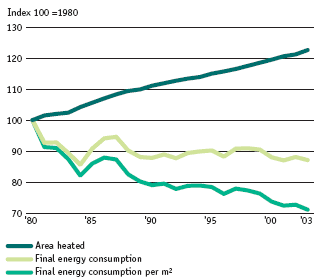
Source: The Danish Energy Authority and Statistics Denmark
Energy consumption for heating per m² went down 28.9 per cent during the period 1980 to 2003. this drop can be explained partly by improved insulation in older houses and partly by old boilers having been replaced by newer, more efficient natural-gas boilers and district-heating installations. there is also the fact that new houses have lower energy consumption than existing ones. Potential for further efficiency improvement of energy consumption in houses still exists.
Energy consumption for heating has gone down from 179.6 Pj in 1980 to 156.5 Pj in 2003, corresponding to a drop of 12.9 per cent. this decrease has occurred even though the total heated area in the period has gone up 22.6 per cent. the drop in energy consumption occurred from 1980 to 1990. Since then consumption has been fairly stable.
11 Electricity, water and waste consumption in homes
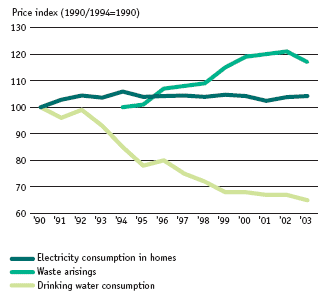
Source: The Danish Energy Authority and the Danish Environmental Agency
This indicator describes resource consumption in homes. the graph shows an index for household consumption of water and electricity from 1990-2003 and waste arisings 1994-2003 in relative figures.
Consumption of drinking water by households has been falling markedly. this should, amongst other things, be considered in the context of the 1993 tax reform which introduced a tax on water of DKK 1.00 per m³ in 1994 increasing gradually up to DKK 5 per m³ in 1998. Danish water consumption per capita is low in relation to comparable countries.
Electricity consumption per capita has by and large remained constant for a ten-year period. Waste arisings from households showed a steady increase until 2002, after which arisings dropped until 2003. the increase up to 2002 was 22 per cent, more than economic growth in the period.
Water consumption by households has been successfully reduced and stable electricity consumption has been maintained despite an increase in wealth. on the other hand, waste arisings from households have increased.

Keep check on heating and save money
• Keep the temperature at 18-21°C. this corresponds to setting the temperature control on the radiator at about three.
• always have more than one radiator on at the time. make sure the radiators within the same room are set at the same level.
• always keep the heat on in all rooms, including those that you do not use. Set the temperature control at one, corresponding to about 12°C. the same should apply when you leave on holiday.
• turn the radiators off when you air the room. air rooms by opening many windows for a short period of time.
• When following the above advice, you save heat and contribute to the reduction of global warming and pollution of the air by environmentally harmful sulphur and nitrogen compounds.
• Lowering the room temperature in your house by as little as one degree, can spare the environment for emissions of about 230 kilos of carbon dioxide in a year, if you live in a house of 130 m². at the same time, you save about DKK 500 annually.
• When you save heat, you help reduce global warming and pollution of the air with sulphur and nitrogen compounds that are poisonous for plants and animals. Heat is often produced in ways that lead to emissions of Co² (carbon dioxide) and sulphur and nitrogen compounds. Carbon dioxide in the atmosphere is one on the most significant causes of manmade climate change.

Burn clean – for the sake of the environment and public health
Supplementing your heating system with a wood-burning stove may seem attractive from a private-economic point of view. However, even though firewood is a renewable energy source which reduces emissions of carbon dioxide, there are many examples showing that incorrect use of wood-burning stoves is very detrimental to the local environment.
Particulate matter air pollution has long been known to have negative health effects, especially in terms of respiratory disorders and cardiovascular disease. as a result, we die earlier than we otherwise would.
a significant source of particulate matter air pollution is burning wood for heating. around half of Danish emissions of particles actually stem from wood-burning stoves and boilers. mostly because of incorrect use. When you burn your wood correctly (complete combustion), you minimise the resulting air pollution. the Danish environmental Protection agency has therefore drafted four easy clean-burning recommendations.
1. Use clean and dry wood
Wet wood leads to poor combustion and a lot of smoke. Never burn waste – for example advertising matter, magazines, milk cartons, cardboard, or painted or treated wood.
2. Make sure there is plenty of air
Not enough air leads to many particles in the smoke that are harmful to health. Start the fire with kindling wood, firelighters or some newspaper, so that the fire lights up quickly and properly. Do not lower the air control until the flames are bluish in tone.
3. burn small amounts of wood
The fire needs to catch so that a high temperature is reached quickly. Whenever you put new wood on the fire, you should increase the air ventilation until the dark-yellow flames are gone.
4. Check the smoke coming out of your chimney – it should be almost invisible
if there is too much smoke and it smells bad, then it is likely you are not burning correctly. ask your chimney sweep for advice.
12 co² emissions fromhomes
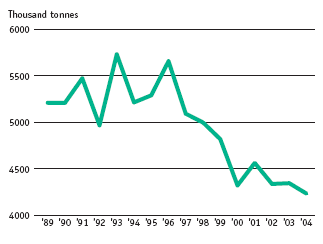
Source: The National Environmental Research Institute
In the period 1990-2003 household emissions of Co², which in 2002 accounted for 6 per cent of overall Danish emissions fell by 15 per cent, primalrily as a consequence of energy efficiency improvements and conversion from oil heating to heating by natural gas or district heating.
13 co² emissions per capita
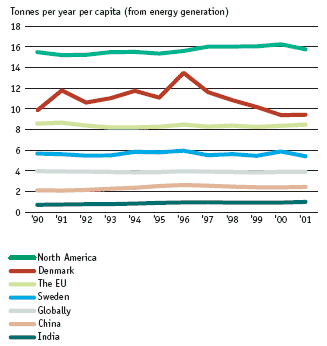
Source: The International Energy Agency
The prospect of harmful climate change in this century is a global problem. international cooperation is therefore pivotal, if we are to tackle this challenge as effectively as possible. manmade emissions of greenhouse gases, such as Co², methane and nitrous oxide etc., contribute to global climate change. We can do something about this through international cooperation and international regulation.
Under the Kyoto Protocol, the eu is obligated to reducing its emissions of greenhouse gases by an average of 8 per cent in the period 2008-2012 relative to 1990. an underlying principle in the eu's climate strategy is that requirements to member States differ depending on conditions such as the member State's energy consumption and economic capabilities. the eu's total reduction obligation under the Kyoto Protocol was distributed among the 15 'old' eu
member States through burden sharing. the eu burden sharing agreement means that this objective is central to Danish climate policy.
The result of negotiations in the eu was large differences in the requirements to the individual countries. Denmark and Germany, for example, need to reduce emissions by 21 per cent, while countries such as Greece and Portugal in the same period are allowed to increase their emissions by 27 per cent and 25 per cent respectively.
The development in Denmark, according to the iea’s calculations, shows a fall of 4.3 per cent. For the eu as a whole, there is a drop in emissions per capital of 0.6 per cent covering such large differences as e.g. a growth of 34 per cent in Spain and of 47 per cent in Portugal and a drop in Germany of 15 per cent and in the united Kingdom of 6 per cent. For eastern europe and the former USSR states, reorganisations in the 1990s have led to a marked fall in greenhouse gas emissions, which is also reflected in a drop in emissions per capita, with, for example a drop of 33 per cent in the former USSR.
Emissions per capita in developing countries are still significantly lower than those of the industrialised countries but are expected to increase in the future as total emissions show large increases in for example China (+ 36.0 per cent) and
india (+ 71.4 per cent). For the world as a whole, there is a drop in emissions per capita of 1.8 per cent, covering an increase in total emissions of 15 per cent and an increase in population of about 17 per cent.

14 Consumption and recycling of glass and paper
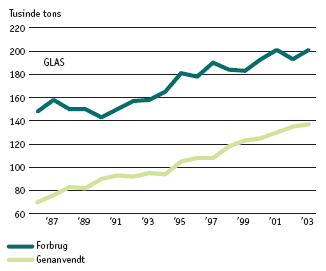
Source: The Danish Environmental Protection Agency
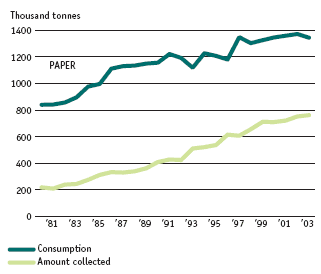
Source: The Danish Environmental Protection Agency
Consumption of glass generally increased from 1990 to 2002. on the other hand, recycling of glass also increased steadily throughout the period, reaching 135,000 tonnes in 2002. this corresponds to a recycling rate of 70 per cent.
Paper consumption generally increased during the period. the collection trend for paper and cardboard for recycling also increased throughout the period, although from 1990 collection amounts accelerated, reaching 752,000 tonnes in 2002. this corresponds to a recycling rate of 55 per cent of the total volume of paper and cardboard.
Cardboard and paper must be separated as prescribed by the municipality. often they must be separated from each other because the fibres in paper are longer than in cardboard and may be used for other products than cardboard and paperboard. the fibres can be reused up to ten times.
Every day, year round, the individual Dane generates about 7 kg of waste. much of this waste may be recycled, which means we can save the energy which would otherwise have been required to break down the products and produce new ones. For example, lots of energy is required to produce new glass, but when you hand in glass for recycling, it will be remelted.
In this way you help reduce the resources used for glass production.


recycling makes waste a resource
• Remember that the municipalities are responsible for waste management in Denmark. Find out what you are required to do with your waste in your local municipality.
• Hand in glass and bottles for recycling. Window glass, light bulbs and fluorescent tubes must not be put in the glass container.
• Hand in cardboard and paperboard for recycling. For example in a container for cardboard or at the recycling station nearest to you.
• Hand in newspaper, adverts, weeklies and envelopes for recycling.
• Compost your garden waste, or take it to the recycling station.
• Hand in batteries according to the municipality’s instructions, for example at the recycling station or with the mobile waste collector. the greatest problem with environmentally dangerous batteries and button cell batteries is the contents of cadmium and mercury. Cadmium damages the kidneys and reproduction ability in humans and animals and therefore must not be spread to the environment. Cadmium can be recycled.
• If there is a waste scheme for biowaste where you live, all your kitchen waste must be separated from the remaining waste and put in a separate waste bin.
Version 1.0 July 2007, © Danish Environmental Protection Agency